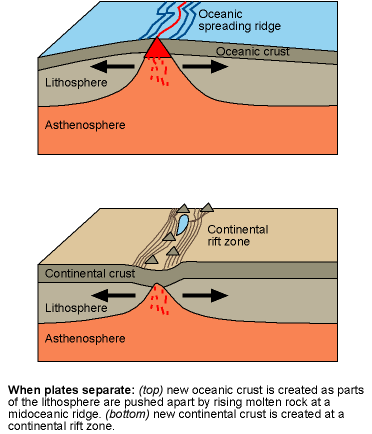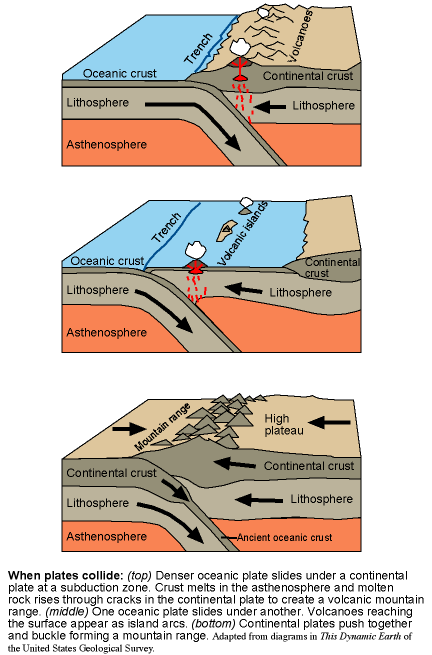
Video lecture for Geology section
The Earth's lithosphere is broken up into chunks called plates with densities around 3. Oceanic plates are made of basalts (cooled volcanic rock made of silicon, oxygen, iron, aluminum, & magnesium). Oceanic crust is only about 6 kilometers thick. The continental plates are made of another volcanic type of silicates called granite. Continental crust is much thicker than oceanic crust---up to 35 kilometers thick. With densities of 2.7 to 2.8 (times that of water), continental plates are less dense than the oceanic plates which have densities of 3. The mantle convection causes the crustal plates to slide next to or under each other, collide against each other, or separate from one another in a process called plate tectonics. Plate tectonics is the scientific theory that describes this process and how it explains the Earth's surface geology. The Earth is the only planet among the terrestrial planets that has this tectonic activity. This is because plate tectonics probably requires liquid water to solidify the oceanic plates at the mid-ocean ridges where seafloor spreading is happening (see below) and more importantly, the liquid water lubricates the asthenosphere and softens the lithosphere enough so that the plates can slide past or under one another. Venus has enough interior heat to have convection in its mantle like the Earth, but through processes described in another section, Venus lost its water, so its plates are poorly lubricated at best.
Plate tectonics is a relatively recent theory having been proposed in the late 1960s and finally being verified enough so that it could be put in the introductory geology textbooks in the 1980s (remember all of the peer review, error-correction process that happens before something is fit to print in a textbook). What finally made scientists accept the theory? Today we can easily measure plate motion using GPS sensors on either side of plates. As in any robust scientific theory there are multiple lines of evidence supporting the theory. For plate tectonics, the evidence is continental motion, seafloor spreading, earthquake and volcano locations, and the difference between the seafloor crust and continental crust. I will give just a brief outline of the evidence for plate tectonics here. See the nice, detailed presentation from the USGS's Dynamic Earth online text.
The figure below shows the boundaries of the major plates on top of a map of the Earth. The arrows show the direction of the plates with respect to each other. The white areas are elevations greater than 2400 meters (7900 feet) above sea level. This figure is an adaption of a map in the "Plate Tectonic Movement Visualizations" website of the Science Education Resource Center at Carleton College and the plate motion data from This Dynamic Earth of the USGS. Select the figure to bring up an enlarged version of it.
Places where warm rock from the asthenosphere rises along weak points in the lithosphere can push apart the lithosphere on both sides (see the figure below). These places are at the mid-ocean ridges (such as the Mid-Atlantic Ridge that bisects the Atlantic Ocean) and continental rift zones (such as the East Africa Rift Zone). Sea-floor spreading caused the Atlantic Ocean to grow from a thin sliver 100 to 200 million years ago to its present size and now continues at a rate of about 25 kilometers per million years.

Rising warm asthenosphere material does not happen exclusively along plate boundaries though. With hotspot volcanism, a plume of hot material from the mantle, possibly from as deep as the core-mantle boundary, rises to break through the lithosphere in the middle of a plate to create a volcano far from the plate boundary. As the plate moves over the mantle plume, the original volcano stops erupting and a new volcano forms. The most famous of hotspot volcanism on Earth is the one that formed the Hawai'i-Emperor volcanic chain but another noteworthy one is the track from India to the island of Reunion (off of Madagescar). On one end of the chain the volcanoes are erupting now and the volcanoes get progressively older toward the other end of the chain, so the chain shows how the plate has moved over the mantle plume during the past many millions of years. Hawai'i is the youngest of the main Hawaiian islands visible above sea level and Ni'hau is the oldest but the Hawaiian chain continues on out northwestward from Gardner to Kure that are coral atolls built on top of now submerged volcanoes. Another example of hotspot volcanism is the large volcanoes on Mars, including Olympus Mons but because Mars does not have moving plates, the martian hotspot volcanoes could grow to enormous sizes.
The pushing apart of some plates from each other means that others will collide. The oceanic lithosphere is cooled by contact with the ocean water. When oceanic crust runs into oceanic crust or into continental crust, the denser lithosphere material slides under the less dense lithosphere material, eventually melting in the deepest layers of the mantle. The region where the lithosphere pieces contact each other is called a subduction zone and a trench is formed there. At the subduction zone, the right combination of temperature, pressure and rock composition can create small pockets or fissures of molten rock in the solid asthenosphere that then rise up through cracks in the crust to create a range of volcanoes (see the figure below). In another section you will see that this has a profound effect on regulating the climate of the Earth.
When two continental pieces bump into each other, they are too light relative to the asthenosphere and too thick for one to be forced under the other. The plates are pushed together and buckle to form a mountain range. It also possible for two plates to slide past each other at what is called a transform fault such as the San Andreas Fault in California and the Anatolian Fault in Turkey.

Examples of ocean-continental plate subduction include the Juan de Fuca plate off the coast of northwestern United States subducting under the North American continental plate to create the Cascade volcano range, the Nazca plate subducting under the western edge of the South American plate to create the Andes range of volcanic mountains. An example of the ocean-ocean plate subduction are the chains of islands on the Asia side of the Pacific: the Aleutians, Japan, Philippines, Indonesia, and Marianas. An example of continent-continent plate collision is the Indian plate running into the Eurasian plate to create the Himalayas.
A lot of information and videos about Earth's plate tectonics are available on the EarthScope website. Students and teachers should also check out the IRIS Earth Science animations website for many high-quality and detailed animations of the plate tectonic activity occuring around the globe.
To end the Planet Interiors section, here is a summary of the terrestrial planet surface shaping agents at work today.
| Surface Shaper Agent | Mercury | Venus | Earth | Moon | Mars |
|---|---|---|---|---|---|
| Impact Cratering | Yes | Minor | Minor | Yes | Yes |
| Volcanism (needs internal heat) | No (only long ago) | Yes | Yes | No (only long ago) | No (only in the past) |
| Tectonics (needs internal heat) | No (only long ago) | Yes | Yes | No | No (only in the past) |
| Erosion | No (no liquid or atmosphere) | No (no surface winds) | Yes (ice, water, air) | No (no liquid or atmosphere) | Yes (air today + water in past) |
Looking at the table, we can draw some conclusions as to what planet properties will determine the type of planet surfacing that can occur. Impact cratering can occur on any object with a solid surface at any time. If a planet has an atmosphere and is still geologically active, then the effects of impact cratering will be erased. Volcanism and Tectonics require the planet to be of sufficient size to still have heat in its interior. Erosion requires an atmosphere with winds to work efficiently. Even better is if liquid can be present to add to the weathering by the atmosphere. Erosion works best on Earth. Earth is of sufficient size to hang on to its atmosphere (unlike the Moon). Earth is at a good distance from the Sun so it is not too hot for its atmosphere to either evaporate away or become excessively thick that winds will not blow on the surface (as is the situation with Venus). Also, its good distance from the Sun enables the surface temperatures to be warm enough for liquid water to flow (unlike Mars) and so its atmosphere does not freeze out on its surface as happens with Mars. Earth's rotation is fast for its size (unlike Venus), so it can create complicated air circulation (wind) patterns as well as ocean currents. Also, rapid rotation enables the creation of the magnetic field shield to protect a planet's atmosphere from the solar wind.
| erosion | impact cratering | plate tectonics |
|---|---|---|
| tectonics | volcanism |
I teach in a college located in the southern end of the San Joaquin Valley of California. We are very aware that we live in a place where a serious earthquake can occur and every October the college participates in the Great ShakeOut. Below is a list of some resources for preparing for and recovering from earthquakes. Thanks to Astronomy Notes reader Katie Cook for locating several of these resources.
![]() Go back to previous section --
Go back to previous section --
![]() Go to next section
Go to next section
last updated: October 16, 2024